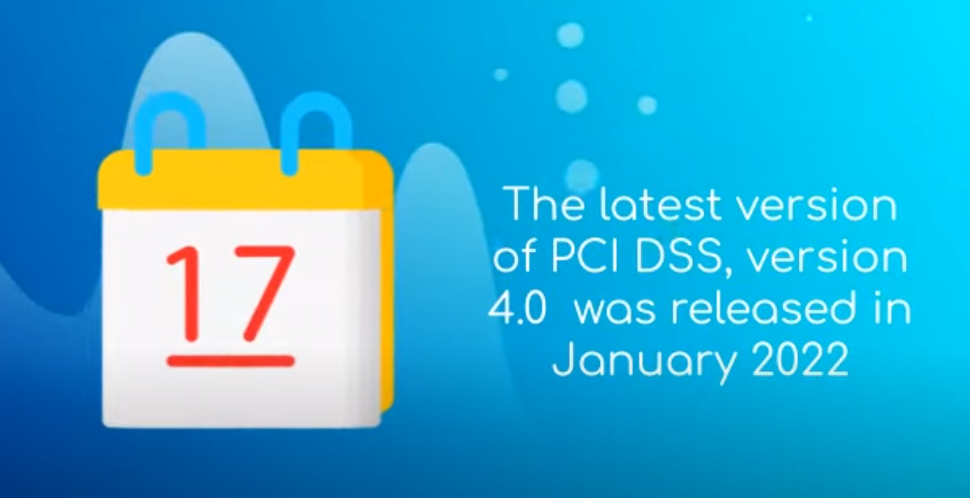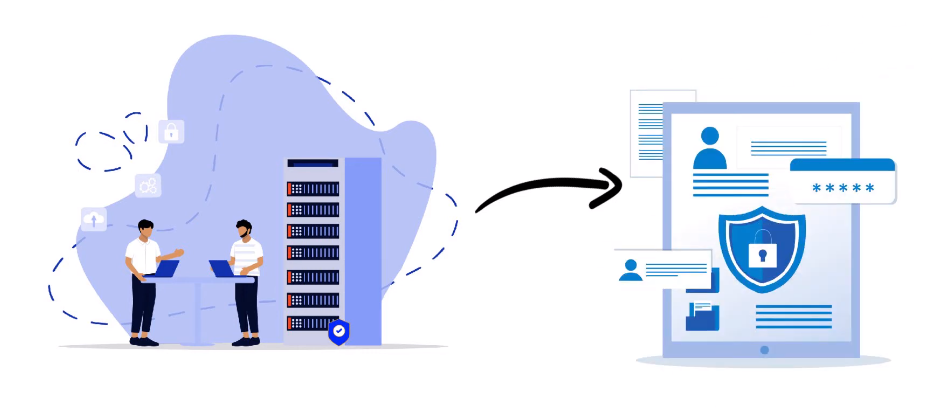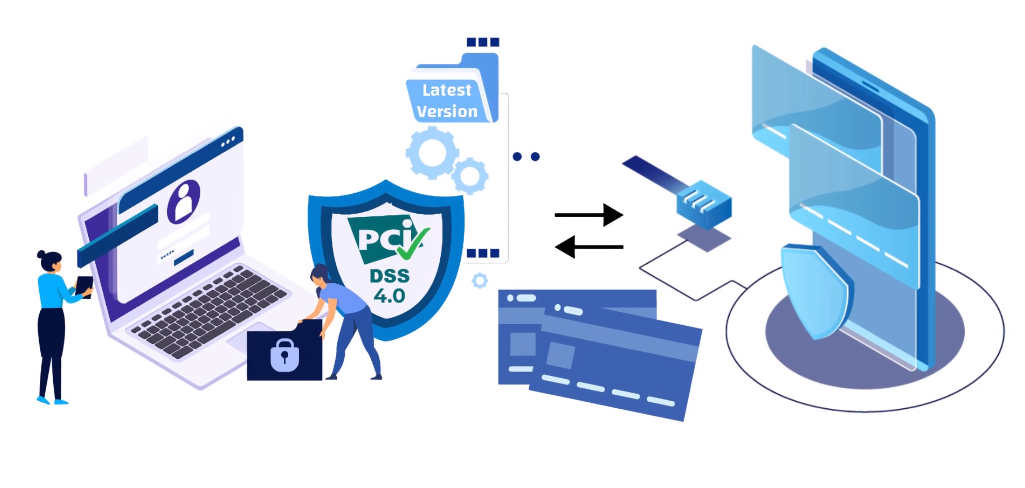Introduction

PCI DSS is a set of security standards to ensure that all businesses that accept, process, store or transmit credit card information maintain a secure environment. The standard was created by major payment cards companies such as Visa, MasterCard and American Express to help reduce the risks associated with credit card fraud and data breaches.
PCI DSS consists of twelve requirements that are split into six categories. These categories include building and maintaining a secure network, protecting cardholder data, maintaining a vulnerability management program, implementing strong access control measures, regularly monitoring and testing networks and maintaining an information security policy.
PCI compliance protects businesses from potential financial losses and safeguards their customers’ personal information. With the rise of online transactions, cybercriminals are constantly looking for vulnerabilities they can exploit to steal sensitive information, such as credit card details. PCI DSS compliance helps prevent such attacks by creating a secure environment that is difficult for hackers to penetrate.
Non-compliance can result in severe consequences for businesses. The most significant consequence is the potential loss of customer trust and confidence. This could lead to lost revenue and damage to the company’s reputation. In addition, non-compliance can result in fines and penalties from payment card brands, which can have serious financial implications for small businesses. On the other hand, complying with PCI DSS requirements can benefit businesses, such as reducing the risk of data breaches and frauds, improving customers’ trust and loyalty and reducing the scope of audits by payment card brands.
Understanding PCI DSS
History And Evolution Of PCI DSS

The Payment Card Industry Data Security Standard (PCI DSS) was first introduced in December 2004 by major credit cards companies such as Visa, MasterCard, American Express, Discover and JCB. PCI DSS aims to provide security standards for all entities that process, store, or transmit cardholder data to prevent fraud and protect sensitive information. Since its introduction, the standard has undergone several revisions and updates.
In 2006, PCI DSS version 1.1 was released with minor changes and clarifications. In 2008, version 1.2 was introduced, which included more detailed requirements for vulnerability management programs and wireless networks. Version 2.0 was released in 2010, bringing significant changes, such as new requirements for penetration testing and file integrity monitoring.
The latest version of PCI DSS is version 3.2.1, released in May 2018 with minor revisions to address issues related to SSL/early TLS vulnerabilities and effective dates for migration from these protocols to TLS v1.2 or higher standards by June 30th,2022.
Who Is Responsible For PCI DSS Compliance?
PCI DSS compliance is responsible for both the merchant and the payment processor. Merchants must adhere to all requirements outlined in the standard, such as maintaining secure networks and systems, implementing access control measures, and regularly monitoring and testing their security systems. They must also submit an annual attestation of compliance (AOC) to their acquiring bank or payment processor.
Payment processors are responsible for ensuring their merchants comply with PCI DSS. This includes supporting and guiding in achieving compliance, conducting regular assessments of merchants’ security practices, and reporting non-compliance issues to the appropriate authorities.
The Different Levels Of PCI DSS Compliance:
The Payment Card Industry Data Security Standard (PCI DSS) standards are divided into six levels with different compliance requirements.
- Level 1 applies to businesses processing over six million transactions annually and requires an annual on-site assessment by a Qualified Security Assessor (QSA).
- Level 2 applies to merchants processing between one and six million transactions annually and requires an annual self-assessment questionnaire and quarterly vulnerability scans.
- Level 3 applies to merchants processing between 20,000 and one million e-commerce transactions annually and requires an annual self-assessment questionnaire and quarterly vulnerability scans.
- Level 4 applies to merchants processing between 100,000 and 200,000 e-commerce transactions annually and requires an annual self-assessment questionnaire and a quarterly vulnerability scan.
The Requirements Of PCI DSS
Building And Maintaining A Secure Network
One of the key requirements of PCI DSS is to use strong encryption protocols to safeguard cardholder data during transmission over public networks. Organizations can also implement firewalls and other access control measures to prevent unauthorized access to their networks. These security measures must be regularly monitored and tested to ensure they remain effective against evolving threats.
Protecting Cardholder Data
The PCI DSS sets strict requirements for businesses to securely store, transmit, and process cardholder data. These include implementing firewalls, encrypting data transmissions, restricting access to cardholder information on a need-to-know basis, regularly testing security systems and processes, and complying with strict password policies.
Maintaining A Vulnerability Management Program
Maintaining a vulnerability management program is critical in ensuring the security and compliance of any organization, particularly those handling sensitive data like payment card information. A vulnerability management program should include regular scanning and testing of all systems and applications for vulnerabilities, as well as remediation plans to mitigate any identified risks.
Regular scanning and testing can be achieved through automated tools that identify potential vulnerabilities in the organization’s network or systems. These tools should be used on a scheduled basis, with results reviewed by trained personnel who are capable of identifying false positives or negatives. Remediation plans should include prioritization based on severity level, with critical issues addressed first.
Implementing Strong Access Control Measures
The standard requires that you implement strong and effective measures to limit access to cardholder data, ensuring that only authorized personnel can view or manipulate sensitive information. This includes implementing strict password policies, multi-factor authentication protocols, and role-based access controls.
To achieve compliance with PCI DSS, you must ensure that all employees who have access to cardholder data understand their responsibilities in protecting this information. It’s essential to conduct regular training sessions and awareness programs to educate staff on safe handling practices for sensitive data. You should also restrict physical access to areas where cardholder data is stored, such as server rooms or filing cabinets.
Regularly Monitoring And Testing Networks
To comply with PCI DSS, businesses should implement automated tools that continuously monitor their networks for any suspicious activity. These tools can detect unusual patterns of behavior or unauthorized access attempts in real-time, helping the organization to respond quickly and mitigate any potential risks.
Maintaining An Information Security Policy
The Payment Card Industry Data Security Standard (PCI DSS) requires organizations to have a documented information security policy that outlines procedures and guidelines for safeguarding customer data. This policy should cover access control, network security, physical security, risk management, and incident response.
Achieving PCI DSS Compliance
How To Prepare For A PCI DSS Assessment?

Understand the scope of the assessment: This means identifying all systems and processes that store, process, or transmit cardholder data. Once this is done, ensuring these systems are secure and compliant with all relevant PCI DSS requirements is important.
Conduct a gap analysis: This involves reviewing current security controls and comparing them against the standard’s requirements. Any gaps or weaknesses should be identified and addressed before the assessment occurs.
Understanding The Different Types Of Assessments
- Vulnerability Assessments: This assessment mainly focuses on identifying weaknesses in the network, applications, or other systems that attackers could exploit. The objective of vulnerability assessments is to discover potential vulnerabilities and provide recommendations for remediation.
- Penetration Testing: A penetration test simulates a real-world attack scenario to identify an organization’s infrastructure’s vulnerability to attacks. It involves ethical hacking techniques such as exploitation, social engineering, and phishing attempts, allowing testers to find gaps in security before real attackers exploit them.
- Risk Assessments: Risk assessments evaluate the likelihood and impact of potential threats to determine how they should be managed or mitigated. This type of assessment considers technical factors and human and environmental factors that could affect an organization’s security posture.
Common Challenges In Achieving PCI DSS Compliance
One of the biggest challenges in achieving PCI DSS (Payment Card Industry Data Security Standard) compliance is understanding what data needs to be protected. Merchants must protect all payment card information, including the cardholder’s name, account number, expiration date and service code. This means businesses must have robust processes for securely storing, processing and transmitting this sensitive data.
Another challenge is implementing adequate security measures to protect against unauthorized access or theft of payment card information. This includes firewalls, encryption technologies and access controls to ensure that only authorized individuals can access sensitive data. Additionally, merchants must regularly monitor their systems for potential vulnerabilities or breaches and take prompt action if any are detected.
Best Practices For Maintaining Compliance
Regularly review your policies and procedures related to data security. This will help ensure they are up-to-date and aligned with the latest version of PCI DSS. Perform regular vulnerability scans and penetration testing to identify potential vulnerabilities in your network. This will help you proactively address those vulnerabilities before attackers can exploit them. Ensure that all personnel handling cardholder data are trained on PCI DSS requirements and their role in maintaining compliance. Regular training sessions can be scheduled as part of ongoing efforts to keep everyone informed about security risks and protocols for mitigating them.
Penalties For Non-Compliance
Fines And Penalties For Non-Compliance
Organizations that fail to comply with these regulations may face hefty fines from payment card networks, such as Visa and Mastercard. Fines for non-compliance can vary depending on the violation’s severity and the organisation’s size. For example, small businesses may be subject to fines ranging from $5,000 to $50,000 monthly for non-compliance. In contrast, larger organizations could face fines exceeding $100,000 per month.
Additionally, non-compliant organizations may lose their ability to accept credit card payments. This can be a significant blow to businesses that rely heavily on credit card transactions. Organizations must prioritize compliance with PCI DSS regulations to avoid costly consequences and maintain customer trust.
Impact On Brand Reputation
Non-compliance or a breach of PCI DSS standards could damage the company’s credibility and cause long-term harm to its reputation.
The Future Of PCI DSS
Changes In PCI DSS 4.0

The PCI DSS 4.0 update brings significant changes that aim to better align with modern payment processing methods and address emerging threats. One major change in PCI DSS 4.0 is the focus on risk assessment, which includes incorporating more dynamic threat intelligence into compliance practices. This means merchants must continuously monitor for new vulnerabilities and adjust their security measures accordingly.
Another key update in PCI DSS 4.0 pertains to multi-factor authentication requirements, which have been expanded beyond remote access connections to include all non-console administrative access. Additionally, there are new requirements for securing payment software development processes.
The Impact Of New Technologies On PCI DSS Compliance
New technologies have brought a paradigm shift in how businesses operate, including those dealing with payment card transactions. This has led to increased scrutiny from regulatory bodies like the Payment Card Industry Security Standards Council (PCI SSC) to ensure that companies comply with PCI DSS standards. These regulations are necessary to safeguard sensitive cardholder information and prevent data breaches.
How To Stay Ahead Of PCI DSS Requirements?
- Conduct regular security assessments and audits. This can help identify any areas of weakness in your payment processing systems or data storage practices, enabling you to take corrective action before a breach occurs. Work with an experienced security assessor who understands the latest standards and can provide detailed recommendations for improvement.
- Employee training and education. All staff members who handle payment information should be familiar with PCI DSS compliance requirements and best practices for data security, such as using strong passwords, encrypting sensitive data, and avoiding phishing scams. Regular training sessions can help reinforce these principles and ensure your team stays up-to-date on the latest threats and solutions.
Benefits Of PCI DSS Compliance
Enhanced Security And Reduced Risk Of Data Breaches
By adhering to the PCI DSS, businesses can reduce the risk of data breaches and protect sensitive customer information. PCI DSS enhances security requires businesses to implement firewalls and encryption technologies. These measures help prevent unauthorized access to sensitive data by keeping it encrypted during transmission and storage. The PCI DSS also mandates regular vulnerability scans and penetration testing to identify potential vulnerabilities in a business’s systems or processes.
Improved Brand Reputation And Customer Trust
Complying with the Payment Card Industry Data Security Standard (PCI DSS) helps improve brand reputation and customer trust. Customers want to know that their personal information is secure when making purchases, and by adhering to PCI DSS guidelines, businesses can demonstrate their commitment to protecting sensitive data.
A company’s positive reputation regarding security measures can be a significant selling point for customers. Improved brand reputation from complying with PCI DSS standards translates into increased customer loyalty and repeat business. Customers are more likely to return if they feel confident that their payment details are secure.
Reduced Costs Associated With Data Breaches
By adhering to PCI DSS, companies can decrease the likelihood of a breach, reducing the damage and expenses associated with such an event. In addition, PCI DSS compliance also offers cost savings through streamlining processes and improving efficiencies. For instance, companies can reduce the risk of fraud and unauthorised transactions by implementing secure payment systems and regularly monitoring them for vulnerabilities. This not only saves money but also improves customer trust and loyalty.
Frequently Asked Questions (FAQs)
What Is A PCI DSS Assessment?
A PCI DSS assessment evaluates the security level of a company’s payment card processing system. This assessment ensures that the organization complies with the Payment Card Industry Data Security Standard (PCI DSS). The PCI DSS is a set of requirements designed to prevent credit card fraud and ensure secure online transactions. Compliance with these standards helps businesses maintain customer trust and avoid costly data breaches.
How Often Should I Conduct A PCI DSS Assessment?
It is recommended that PCI DSS assessments be conducted every 90 days or whenever significant changes are made to your business processes or systems that handle payment card data. Your organization may also need to conduct interim assessments if it experiences a breach or other security incident involving payment card data.
Who Is Responsible For PCI DSS Compliance Within An Organization?
Executive management is responsible for ensuring that the appropriate controls are in place to achieve and maintain PCI DSS compliance. This includes appointing an individual or team to oversee compliance efforts.
What Is The Difference Between PCI DSS Compliance And PCI PA-DSS Compliance?
While both compliance measures aim to ensure that credit card information is protected during transactions, there are key differences between the two.
PCI DSS compliance is mandatory for any business handling credit card information. It sets standards for securing payment data from theft or fraud by implementing specific best practices, including maintaining a secure network infrastructure, encrypting sensitive data during transmission and storage, and regularly monitoring security systems.
In contrast, PCI PA-DSS (Payment Application Data Security Standard) compliance specifically applies to software providers who develop payment applications that handle consumer’s sensitive payment information. The standard ensures that these applications are secure and meet all necessary requirements before being used in the market. This includes encryption methods for stored credit card data, access restrictions on sensitive areas of code or files in the application.
What Is The Cost Of Achieving PCI DSS Compliance?
Achieving PCI DSS compliance can be quite costly, both in terms of finances and resources. The cost of achieving compliance varies depending on the size and type of business, as well as the level of compliance required. For small businesses, the cost may be 5000-20000$, but for larger enterprises that process a high volume of transactions each day, the costs can be substantial.
Does PCI DSS Compliance Guarantee Security Against Data Breaches?
Compliance with the standards set by PCI DSS helps businesses identify and address vulnerabilities in their payment processing systems, but it’s important to understand that these standards are simply guidelines and not foolproof solutions.
Conclusion
The Payment Card Industry Data Security Standard (PCI DSS) is a comprehensive framework designed to protect cardholder data from potential threats. It establishes a set of security requirements that all organizations handling card payments must adhere to in order to maintain trust with their customers and avoid costly breaches. Compliance with PCI DSS is not optional for merchants, as failure to comply can result in hefty fines, legal action, and irreparable damage to reputation.
